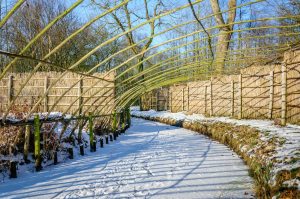
Winter can be tough on your garden, and one of the sneakiest culprits is desiccation. While you might think your plants are safely dormant, they’re actually fighting a battle against moisture loss that could spell ensue come spring.
Understanding how to protect your garden from this process will preserve the investment you’ve made in your landscape. Let’s dive into everything you need to know to keep your garden alive through the coldest months.
What Is Desiccation?
Desiccation, or winter burn, is when your plants lose water faster than they can replace it. This can happen when an environment contains low soil moisture, freezing temperatures, and blowing wind. Your evergreens are particularly vulnerable because they continue losing moisture through their needles even when their roots can’t absorb water from frozen ground.
The process is like trying to drink through a straw that’s been pinched shut. Your plants keep “breathing out” moisture, but they can’t “drink in” replacement water from the frozen soil below. Plants most vulnerable to winter burn include:
- Fir trees (showing yellowish or red needle tips)
- Spruces and pines (displaying yellow-brown to red coloration)
- Broad-leafed evergreens like rhododendrons (browning leaf margins)
- Newly planted shrubs and trees
- Plants in exposed, windy locations
How Desiccation Affects Your Winter Garden
When desiccation strikes, the damage runs deep, starting with leaves and needles that turn brown and crispy at the edges. These damaged areas often appear on the side of the plant most exposed to the sun and wind.
Your plant’s stems can also become brittle and vulnerable to breaking. Meanwhile, as the root system struggles to function in frozen soil, it creates a cascade effect throughout the entire plant. Evergreens and shrubs bear the brunt of this damage because they maintain their foliage year-round, making them constant targets for moisture loss.
Preventative Measures for Your Winter Garden
Take action before winter sets in to prevent long-term damage! Here are the most effective strategies to protect your garden:
Start Mulching
Apply a thick layer of organic mulch around your plants, covering the entire root zone. Mulch acts like a cozy blanket for your soil; it helps the soil retain moisture, and it insulates roots from temperature fluctuations. Wood chips, shredded leaves, or bark mulch work wonderfully.
Water Before the Ground Freezes
Give your plants a deep drink before the ground freezes solid. Aim for about one inch of water per week, saturating the soil to a depth of 12 to 18 inches. This creates a moisture reservoir that plants can tap into during dry winter periods.
Invest in Windbreaks
Create barriers to shield your sensitive plants from harsh winter winds. Burlap screens work exceptionally well, or you can use temporary fencing wrapped in fabric. Position these barriers on the windward side of your most vulnerable plants.
Use Anti-Desiccant Sprays
These protective coatings form a thin film over leaves and needles to minimize water loss. Apply these sprays in late fall—when temperatures are above freezing but before the harshest weather arrives.
Why You Should Protect Your Garden
Investing time in winter burn prevention pays dividends throughout the year. Here’s what you’ll gain:
- Maintains Plant Health Through Winter: Your plants emerge stronger in spring
- Reduces Springtime Recovery Work: Less pruning of damaged branches and replacement of dead plants
- Preserves Landscape Aesthetics and Investment: Keeps your garden looking beautiful year-round
- Saves Money on Replacements: Protecting existing plants is much cheaper than buying new ones
- Maintains Property Value: A well-maintained landscape adds curb appeal even in winter
How to Choose the Right Protection Method
Consider your plant types and their specific locations. Evergreens in windy spots need windbreaks, while newly planted trees benefit most from mulching and pre-winter watering. Broad-leafed evergreens often require a combination of anti-desiccant sprays and wind protection.
In terms of cost-effectiveness, mulching offers the best bang for your buck; however, anti-desiccant sprays, while more costly, work very well for hard-to-reach areas. Windbreaks require more setup but provide excellent protection for the winter garden.
Partner with Stoeckig for Winter Garden Protection
Don’t let winter desiccation catch your garden off guard. At Stoeckig Landscape Group, we understand Georgia’s unique climate challenges and can help you develop a comprehensive winter protection strategy. Our experienced team knows exactly which plants in your landscape are most vulnerable and can implement the right combination of protection.
Schedule a consultation to ensure your garden thrives through winter and beyond!
